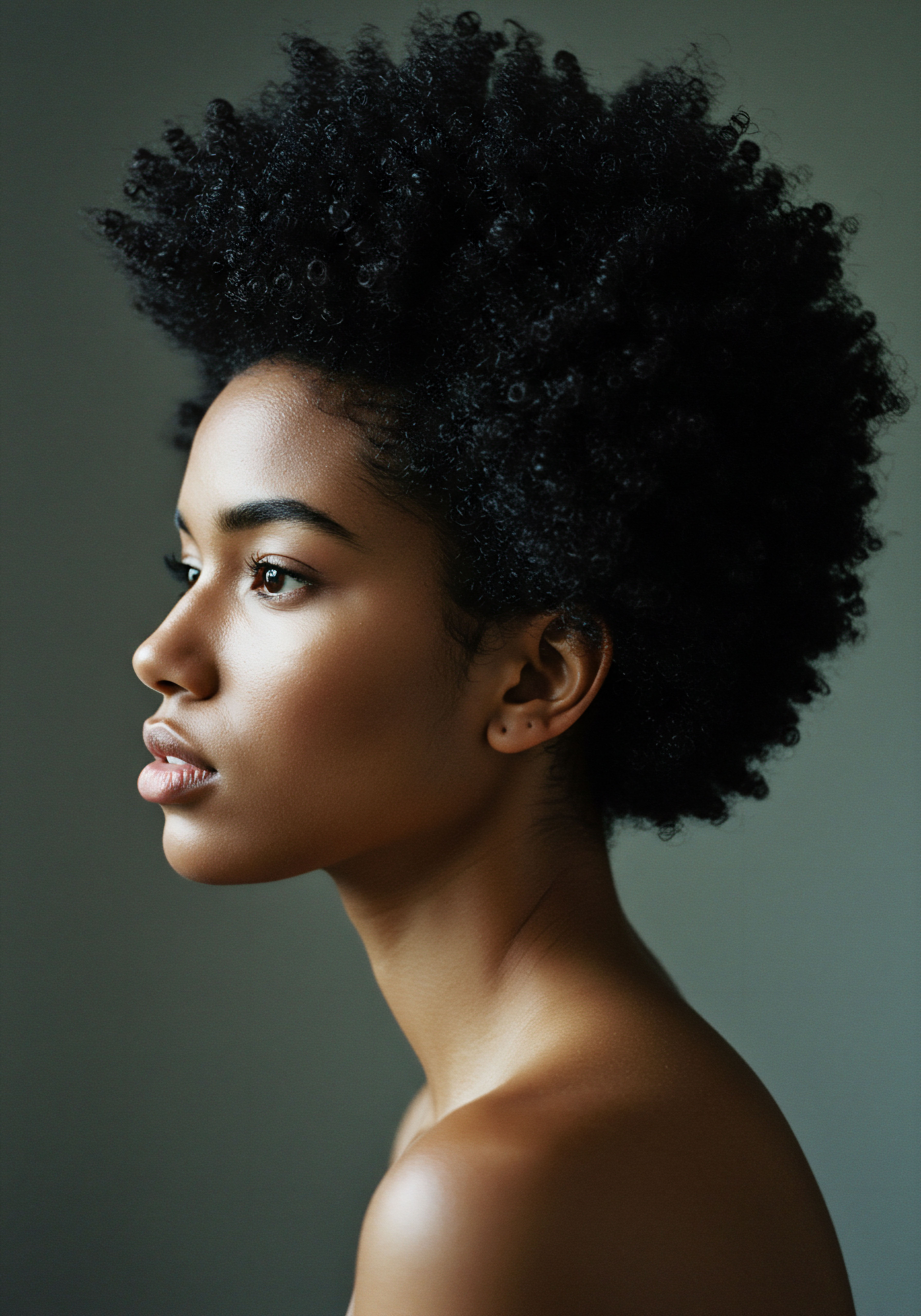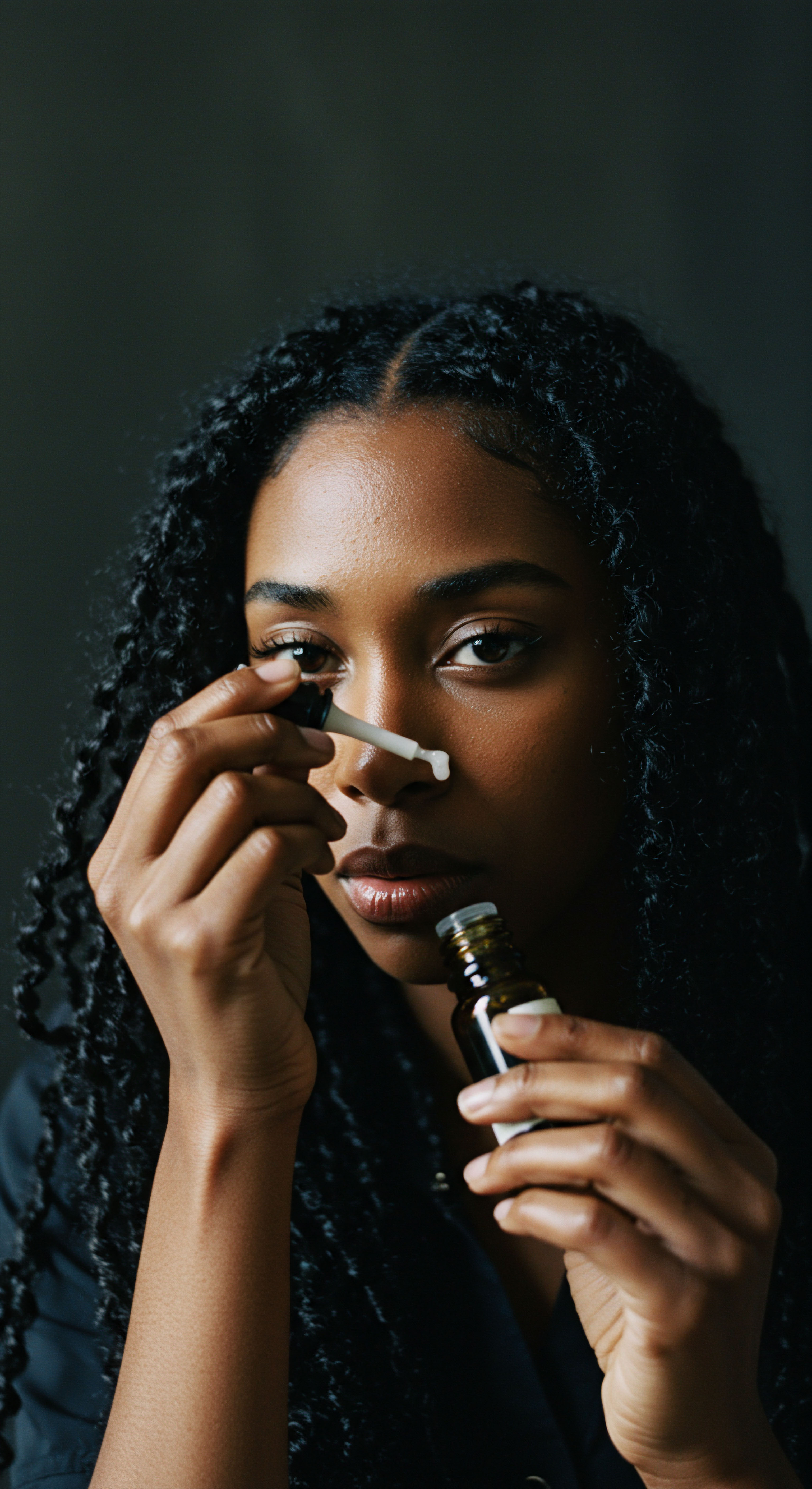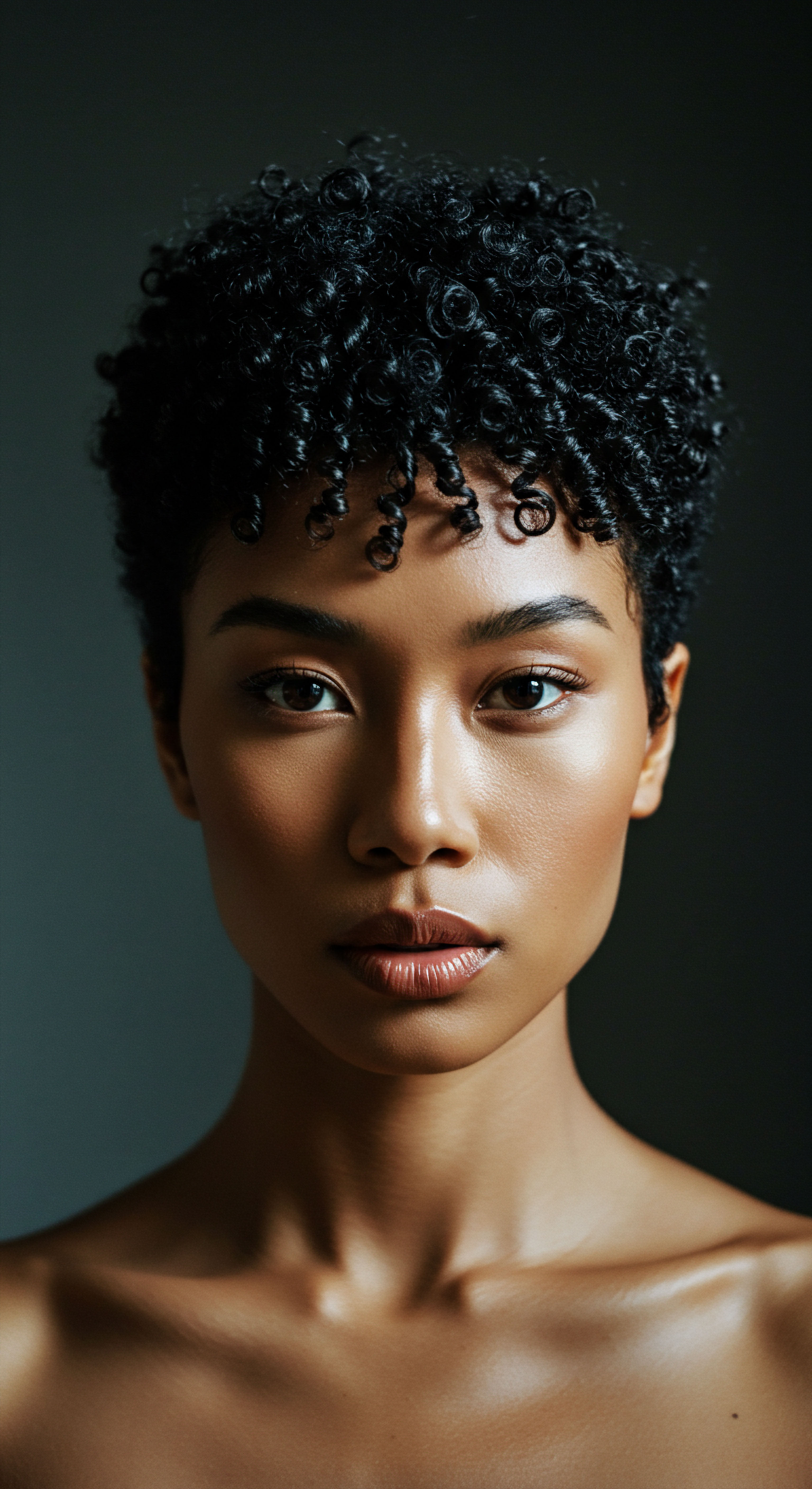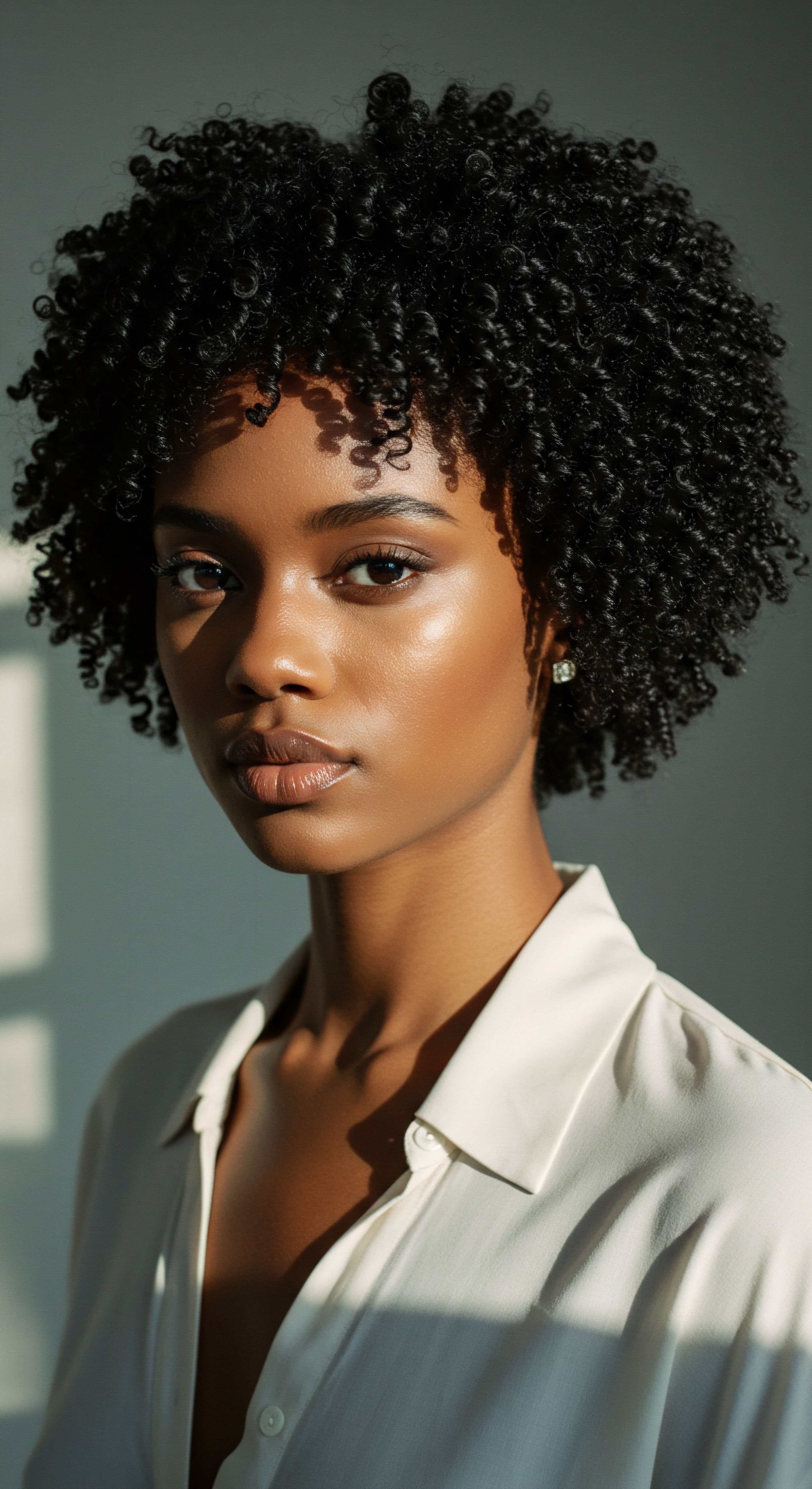
Roots
The scalp, often considered a mere foundation for our hair, possesses a vibrant, unseen world—a delicate ecosystem teeming with microscopic life. This intricate community, known as the scalp microbiome, plays a silent yet profound role in the health and vitality of our hair, particularly for those with textured strands. Understanding this hidden landscape is akin to understanding the soil from which a resilient plant grows; its balance is paramount.
Just as the earth’s health dictates the harvest, the scalp’s microbial equilibrium dictates the health of each hair strand, influencing everything from moisture retention to potential irritations. This deep connection invites us to look beyond surface-level observations and consider the foundational elements that shape this microscopic world.
Our scalp’s surface, a complex biological terrain, serves as home to countless microorganisms. These include a diverse array of bacteria, fungi, and even some viruses, existing in a dynamic, often symbiotic relationship with our skin cells and sebaceous glands. When this balance is maintained, these tiny inhabitants contribute to the scalp’s natural defenses, assisting in barrier function and potentially deterring the overgrowth of less beneficial species.
The health of this microbial community is intrinsically tied to the scalp’s pH, its moisture levels, and the composition of its natural oils. Any shift in these parameters can ripple through the ecosystem, altering the microbial population and potentially leading to discomfort or scalp conditions.
The scalp’s unseen microbial community significantly shapes hair health and resilience.

The Scalp’s Tiny Inhabitants
The dominant residents of a healthy scalp typically include members of the Cutibacterium genus, particularly Cutibacterium acnes, which thrives in the lipid-rich environment of hair follicles. These bacteria are often considered commensal, meaning they generally live in harmony with their host without causing harm. Alongside them, various species of Staphylococcus, such as Staphylococcus epidermidis, are also common. Fungi, particularly the Malassezia genus, are another ubiquitous component of the scalp mycobiome.
While certain Malassezia species are associated with dandruff and seborrheic dermatitis when overgrown, they are present on most healthy scalps in smaller, balanced quantities. The precise ratios and species present vary significantly from person to person, making each scalp’s microbial fingerprint truly individual.
This microscopic diversity is not static; it responds to its surroundings. Consider the very air we breathe. Urban environments, with their higher concentrations of particulate matter and pollutants, introduce different chemical compounds and microbes to the scalp’s surface. These external elements can act as stressors, prompting shifts in the microbial community.
Similarly, the water we use for washing—its mineral content, its pH—can subtly influence the scalp’s environment, creating conditions that either favor or challenge the existing microbial balance. Such environmental factors lay the groundwork for how our scalp’s ecosystem functions, setting the stage for subsequent interactions with our daily practices.

How Does Air Quality Shape the Scalp Microbiome?
The air around us, a silent yet constant companion, deposits various substances onto our skin and scalp. In areas with high levels of Air Pollution, fine particulate matter, volatile organic compounds, and heavy metals settle on the scalp. These microscopic invaders can disrupt the delicate balance of the scalp’s microbial residents. Some pollutants may directly inhibit the growth of beneficial bacteria, while others might provide nutrients for less desirable species, encouraging their proliferation.
Furthermore, pollutants can trigger oxidative stress and inflammation in the scalp, compromising its barrier function. A weakened barrier creates an altered microenvironment, making it more susceptible to microbial imbalances and subsequent irritation or sensitivity. The long-term exposure to these airborne aggressors can slowly but surely reshape the microbial landscape, often without immediate, visible signs.
Even beyond urban smog, variations in humidity and temperature play a part. A consistently humid climate, for instance, can create a moist environment that might favor the growth of certain fungi or bacteria that thrive in damp conditions. Conversely, extremely dry air can dehydrate the scalp, leading to a compromised skin barrier and potentially altering the types of microbes that can comfortably reside there. These atmospheric nuances underscore the foundational role of our immediate surroundings in shaping the very first layer of defense and life on our scalp.
| Microorganism Type Bacteria |
| Primary Species Cutibacterium acnes |
| Typical Role Sebum metabolism, commensal |
| Environmental Influences Humidity, pollution, pH |
| Microorganism Type Bacteria |
| Primary Species Staphylococcus epidermidis |
| Typical Role Skin barrier support, commensal |
| Environmental Influences Temperature, water quality |
| Microorganism Type Fungi |
| Primary Species Malassezia globosa |
| Typical Role Sebum metabolism, commensal (can overgrow) |
| Environmental Influences Humidity, product use, sebum levels |
| Microorganism Type The scalp's microbial residents are sensitive to a range of external and internal conditions. |

Ritual
Moving from the invisible realm of environmental influence, we turn our attention to the tangible practices that define our hair care. Our daily and weekly rituals, the choices we make in products, and the methods we employ, serve as direct interventions into the scalp’s delicate microbial balance. These are not merely acts of grooming; they are acts of tending, either supporting the thriving ecosystem beneath our hair or inadvertently disturbing its equilibrium.
The wisdom of textured hair care has long recognized the importance of gentle handling and specific product selections, often intuitively aligning with principles that science now reveals are crucial for microbial health. Understanding the impact of these conscious decisions allows us to approach our hair care with greater intention, transforming routine into ritual with purpose.

Product Choices and Their Unseen Impact
The myriad of hair products available—shampoos, conditioners, styling creams, gels—each carries a unique chemical signature. The ingredients within these formulations interact directly with the scalp’s surface and its microbial inhabitants. Certain cleansing agents, particularly harsh sulfates, can strip away not only dirt and excess oil but also beneficial lipids and the protective acidic mantle of the scalp.
This disruption in pH and barrier function can leave the scalp vulnerable, creating an environment where opportunistic microbes might flourish. Conversely, formulations rich in emollients, humectants, or certain plant extracts can soothe the scalp and support its natural barrier, indirectly fostering a balanced microbial community.
Consider the role of preservatives in products. While necessary to prevent microbial contamination within the product itself, some preservatives can also exert an antimicrobial effect on the scalp. Overuse of products containing strong antimicrobial agents, even if intended for scalp conditions, can lead to a reduction in the diversity of beneficial microbes, paving the way for dysbiosis.
A diverse microbiome is generally considered a resilient one, capable of adapting to minor stressors. When diversity is diminished, the scalp becomes less capable of maintaining its inherent balance.
Our hair care products, from cleansers to stylers, directly interact with and shape the scalp’s microbial landscape.

How Do Cleansing Frequencies Shape Scalp Microbes?
The frequency of cleansing plays a significant role in modulating the scalp microbiome. For individuals with textured hair, washing practices often differ from those with straighter strands, typically occurring less frequently to preserve moisture and natural oils. This less frequent washing can allow for a natural build-up of sebum, dead skin cells, and environmental particles, which in turn provides a rich nutrient source for certain microbes.
While a certain level of sebum is beneficial, excessive accumulation can lead to an overgrowth of lipophilic (fat-loving) microbes, such as specific species of Malassezia fungi, which are linked to scalp conditions like dandruff. However, washing too frequently with harsh cleansers can strip the scalp, leading to dryness, irritation, and a compromised barrier, which can also disrupt microbial harmony.
Finding the optimal cleansing rhythm involves a thoughtful observation of one’s own scalp and hair needs. For some, a weekly wash may suffice, allowing natural oils to condition the hair while preventing excessive build-up. For others, particularly those with very oily scalps or active lifestyles, more frequent, yet gentle, cleansing might be necessary.
The goal is to remove excess impurities without stripping the scalp’s protective layers, thereby supporting a balanced environment for its microbial residents. This individualized approach underscores the deeply personal nature of hair care, moving beyond universal prescriptions to embrace tailored rituals.
- Sulfate-Free Shampoos ❉ These cleansers offer a gentler alternative, helping to preserve the scalp’s natural oils and pH balance.
- Conditioners with Humectants ❉ Ingredients like glycerin or hyaluronic acid help draw moisture to the scalp, supporting its barrier function.
- Lightweight Oils ❉ Applied sparingly, natural oils can seal in moisture without suffocating the scalp or creating an overly rich environment for certain microbes.

Relay
Our journey into the scalp’s microbial universe deepens now, connecting the threads of environmental influence and personal practice with the intricate biological responses that shape health. The interplay is far more complex than simple cause and effect; it involves a dynamic dance between external pressures, our body’s internal state, and the resilient, yet vulnerable, microbial communities residing on our scalp. This advanced exploration demands a nuanced understanding of how diverse factors—from our diet to our stress levels, from the humidity in the air to the specific chemicals in our treatments—collectively sculpt the delicate microbial balance. It is here that the scientific and the lived experience converge, revealing a tapestry of interconnectedness.

Beyond the Bottle ❉ Systemic Influences on Scalp Microbes
While product choices and cleansing routines are direct interventions, the scalp microbiome is also profoundly influenced by systemic factors—elements of our overall health and lifestyle that ripple outwards to affect our skin, including the scalp. Consider the impact of Diet. What we consume influences our gut microbiome, and emerging research points to a fascinating gut-skin axis, where the health of our digestive system can reflect on our skin.
A diet rich in processed foods, high in sugar, and low in fiber can contribute to systemic inflammation and dysbiosis in the gut, which may, in turn, manifest as inflammation or altered sebum production on the scalp, thereby creating an environment less hospitable to a balanced microbial community. Conversely, diets abundant in prebiotics and probiotics, found in fermented foods and certain plant fibers, can support a healthy gut, potentially fostering a more resilient scalp microbiome.
The often-overlooked influence of Stress also merits significant attention. Chronic stress triggers a cascade of hormonal responses within the body, including the release of cortisol. These hormonal shifts can alter sebum production, suppress the immune system, and even affect the integrity of the skin barrier. A compromised barrier becomes more permeable, allowing irritants to enter and potentially leading to inflammatory responses.
Such changes in the scalp’s physiological state can directly impact the types and quantities of microbes that thrive there, pushing the ecosystem towards an imbalanced state. The silent hum of daily pressures, therefore, finds a tangible expression on our scalp, reshaping its microbial landscape.
The scalp microbiome is a responsive entity, shaped not only by external factors but also by the body’s internal systemic conditions.

Can Specific Chemical Treatments Alter Microbial Diversity?
Chemical treatments, such as relaxers, dyes, and even some anti-dandruff shampoos, represent significant interventions into the scalp’s environment. Relaxers, designed to permanently straighten textured hair, work by altering the hair’s protein structure. The chemicals involved are potent and can cause irritation or even chemical burns on the scalp if not applied carefully. Such damage directly compromises the scalp’s protective barrier, creating open pathways for opportunistic microbes and triggering inflammatory responses.
This disruption can lead to a profound shift in the microbial community, favoring species that thrive in inflamed or damaged skin. Similarly, hair dyes, particularly those containing ammonia and peroxide, can cause scalp irritation and dryness, indirectly impacting the microbial balance by altering the scalp’s pH and moisture levels.
Even products intended to improve scalp health can, paradoxically, alter the microbiome in unintended ways. For example, a study by Chen et al. (2019) in Scientific Reports observed that frequent use of anti-dandruff shampoos containing antimicrobial agents, while effective at reducing Malassezia overgrowth, could also lead to a decrease in the overall diversity of bacterial species on the scalp.
This reduction in diversity, though targeting a problematic fungus, might leave the scalp more vulnerable to other imbalances in the long term, underscoring the delicate dance of intervention and consequence. The aim is not simply to eliminate problematic microbes but to foster a robust and diverse community capable of self-regulation.
Beyond the direct chemical impact, the physical practices associated with these treatments, such as tight braiding or excessive pulling during styling, can also contribute to scalp tension and micro-trauma. These physical stressors, over time, can compromise blood circulation and nutrient delivery to the hair follicles, indirectly affecting the overall health of the scalp and its microbial inhabitants. The accumulation of these factors—chemical, physical, and systemic—paints a comprehensive picture of the many influences that shape the scalp’s intricate microbial world.
- Pollution Exposure ❉ Long-term exposure to urban air pollutants can increase oxidative stress on the scalp, impacting its barrier function.
- Dietary Patterns ❉ A diet low in anti-inflammatory foods and rich in pro-inflammatory components can contribute to systemic conditions that influence scalp health.
- Stress Levels ❉ Chronic psychological stress can alter hormone levels, affecting sebum production and immune responses on the scalp.
- Chemical Treatments ❉ Harsh chemicals in relaxers or dyes can directly irritate the scalp, compromising its barrier and altering microbial composition.

Reflection
As we consider the profound and often unseen world of the scalp microbiome, a deeper appreciation for its intricate balance comes into focus. Our understanding has moved from simple surface observations to a complex interplay of environmental whispers and conscious choices, each leaving an indelible mark on this vital ecosystem. The textured hair journey, with its rich heritage of care and unique physiological considerations, offers a particularly compelling lens through which to view these interactions.
Each gentle touch, every chosen ingredient, and indeed, the very air we breathe, contributes to the delicate harmony or subtle discord beneath our strands. The ongoing discovery within this microscopic realm invites us to approach our hair care with greater awareness, fostering not just external beauty but a profound, internal well-being that truly begins at the root.

References
- Chen, Y. et al. (2019). The effect of dandruff shampoo on the scalp microbiome. Scientific Reports, 9(1), 10834.
- Xu, Z. et al. (2018). The distinct microbial communities on different body sites of healthy individuals. Scientific Reports, 8(1), 10077.
- Wang, Y. et al. (2019). Air pollution and the skin microbiome ❉ a systematic review. Microbiome, 7(1), 162.
- Draelos, H. E. (2010). The effect of water hardness on hair and scalp. Journal of Cosmetic Dermatology, 9(2), 169-173.
- Van der Pol, J. E. J. et al. (2018). Water Hardness and Atopic Dermatitis ❉ A Systematic Review and Meta-analysis. Journal of Allergy and Clinical Immunology ❉ In Practice, 6(5), 1609-1616.e5.
- Gupta, A. K. et al. (2019). The role of diet in dermatology. Journal of Clinical and Aesthetic Dermatology, 12(11), 32-37.
- Arck, P. C. et al. (2020). The skin-gut axis ❉ The relationship between the gut microbiome and the skin. Journal of Investigative Dermatology, 140(1), 24-27.